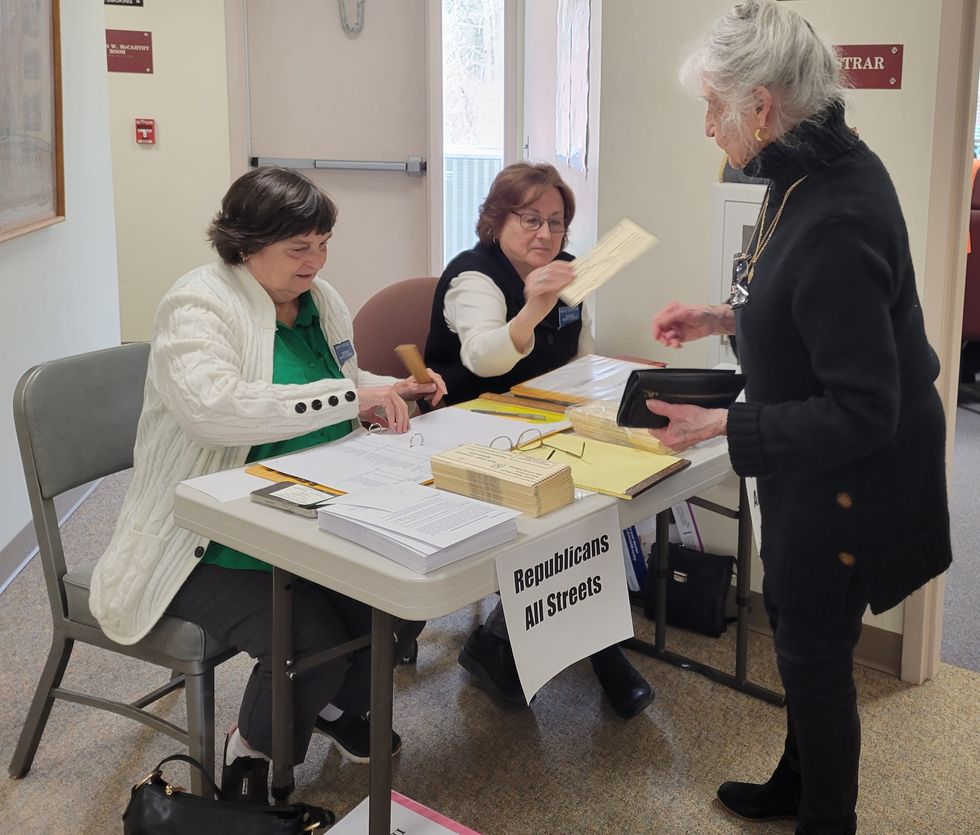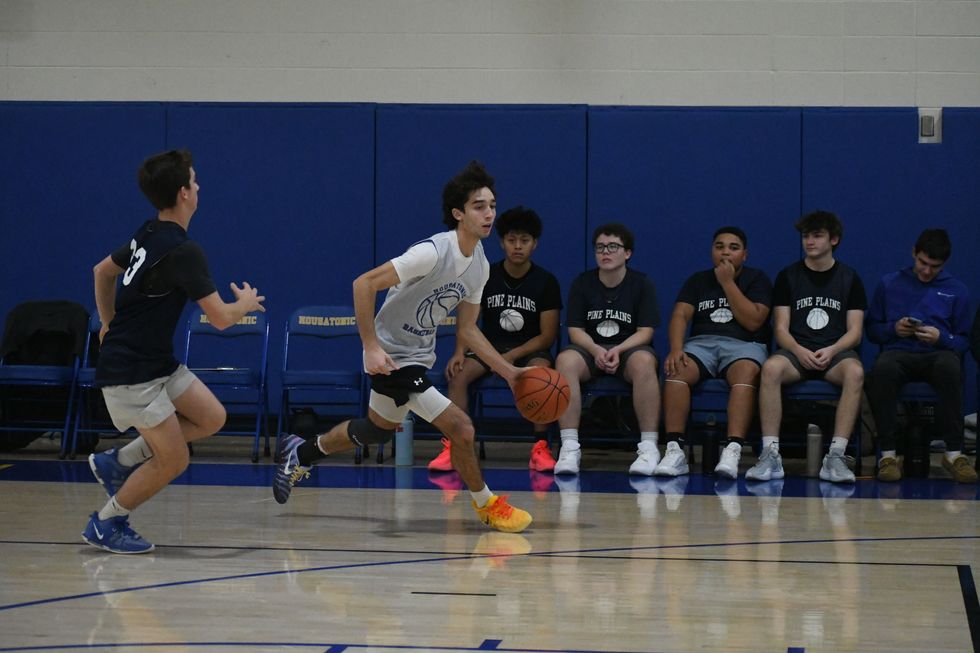Election officials report tepid response to early voting debut

Lisa Sheble, shown here depositing her ballot, was the first person in Salisbury to take advantage of early voting on Tuesday, March 26.
Karin Gerstel

Lisa Sheble, shown here depositing her ballot, was the first person in Salisbury to take advantage of early voting on Tuesday, March 26.
After months of intensive planning and training, election officials across the Northwest Corner were staffed and ready to launch early in-person voting on Tuesday, March 26 for the April 2 Presidential Preference Primary.
Patriotic “Early Voting Today” signs beckoned residents. New equipment and procedures were in place. The voters trickled in.
Despite tepid voter response during the early voting rollout, which poll workers attributed to lack of a strong contest on either the Republican or Democratic ballot, they welcomed the time to work out glitches and meet with and educate voters.
The jury was still out as to whether the expense to staff four early voting days, designed to take pressure off long lines on Election Day and give more flexibility to voters, exceeds the need in the smaller communities.
The Lakeville Journal visited the polling sites of all six Region One towns during early voting launch last week.
The early voting dates for this election were modified to reflect the Good Friday holiday and Easter Sunday. Early voting was held Tuesday, March 26 through Thursday, March 28 and Saturday, March 30. Presidential Preference Primary Day was Tuesday, April 2.
Here are snapshots of how the towns fared:

Cornwall
“Slow. Slow’s the word,” is how Scott Cady, moderator at Cornwall’s town hall voting site, described voter response during the first two hours of the historic first day of early voting on March 26.
Jean Bouteiller, the town’s tax collector, had cast the town’s historic first early ballot. “We had seven total by noon,” noted Republican Registrar Brittany Mosimann. The next day the pace was even slower with seven ballots cast by 3 p.m.
“But everything is working,” said an optimistic Cady, who noted that it was a good test of logistics. “When the fall comes, we don’t want to be learning.”
Registrar Jayne Ridgway noted that each town received $10,500 in state grant funding to offset the costs of training, staffing and equipment including a label maker, scanner and new laptops. But once those funds dry up, she said, the town will be footing the bill.
“If we have an August primary, even a little town like us, will use up our $10,000,” explained Ridgway, who predicted a “60% increase in our budget as a result of early voting.”
“We are very part-time,” noted Mosimann. “We had to spend many hours training in Zoom meetings, which is not typically the time we are in the office.”
“We, the registrars, feel that it will not specifically increase turnout. It will help a few voters who do shift work with lots of extra hours, such as workers at hospitals with 12-hour shifts who get out late, or people who travel a lot,” said Ridgway.
“October early voting will be indicative of voters’ interest, so a little early to gauge now.”

North Canaan
“It’s been a bit slow, but we love doing this. It’s the first day of early voting in Connecticut,” noted poll worker Betsy Devino, who along with Diane Cieslowski, were eager awaiting voters on Thursday, March 28.
As she spoke, North Canaan resident Bunny McGuire stepped up to the table, flashed her ID, claimed her envelope and ballot, and became the town’s fifth early voter at around 11:30 a.m.
Democratic Registrar Patricia Keilty said most of those who voted were either in the building already for town hall business or were reminded of early voting and the Presidential Preference Primary by posts on the Northwest Chatter Facebook page.
She had encouraged as many people as she could to show up and vote so that any glitches in the system could be identified. The strategy paid off, she said. So far, so good.
In an update on Saturday evening, March 30, Keilty reported that a total of 29 electors cast early votes between Tuesday and Saturday.
The town has 1,960 registered voters.

Kent
Long-time Kent resident Rob Gerowe was driving by town hall on Thursday, March 28, when he noticed the early voting sign.
He explained that while his job at the University of Bridgeport allows him flexibility of working some days from home and others on campus, he has an out-of-state, UB alumni reunion coming up which conflicts with the April 2 Presidential Primary.
Gerowe said he had intended to fill out an absentee ballot but was so busy at work that it got put on the back burner. “I was just passing by and decided to vote today to make it easy,” he said. He was the second voter to show up by midday.
According to Registrar Therese Duncan, 13 people voted on Tuesday; 10 on Wednesday and up until Gerowe’s vote on Thursday, only one other vote had been cast.
“Statistically, it has the opportunity to be about 30 percent of the voters who will use early voting,” noted Duncan.
On a bright note, said Deputy Registrar Judy Sheridan, the slow pace allows election officials time to fix hiccups, like one of the registrars’ two computers that went down and a broken label printer.
“We’re very glad we’re doing it now, and not during the presidential election. It’s a good run-through.”

Sharon
The first three days of early voting drew a total of 41 voters to Sharon Town Hall, according to registrar Patricia Chamberlain. “We were pretty happy.”
“We are hoping the state will shrink the number of days for the early ballot, maybe only three days of early voting will be needed. That’s a distinct possibility,” noted registrar Marel Rogers.
“All of us normally work two hours a week, so during early voting it’s like a month’s salary.”
Small towns like Sharon, with limited staff and volunteers, face an unfair cost burden, Rogers noted. “Cities have staff there five days a week, so doing early voting is not going to be so expensive. They are already paying those people.”
Educating residents is another challenge that will hopefully come with time, said BZ Coords, Republican Registrar of Voters. “One person came in to say ‘Nice sign! What are we voting for?’”

Falls Village
“Very stressful, as is any new experience,” is how Falls Village registrar Susan Kelsey, described the new process. The first day’s turnout was seven voters, six the second day and roughly the same number by mid-day on Thursday, March 28.
“By and large, most people wonder why we don’t have no-excuse absentee voting instead,” noted Kelsey. For a small town, this is not cost effective at all. A minimum of four days, eight hours a day at this point …for 19 votes.”
Election officials in Falls Village and elsewhere expressed concern about finding and training enough staff, traditionally retirees, to man the polls for the general election in the fall, which allows 14 days of early voting.
Salisbury
Fifty-eight voters cast their ballots on the first day of early voting in Salisbury, 20 of which did so before lunchtime.
“Early voting is going smoothly as we were well prepared,” reported registrar Jenny Law.
The first person to cast a ballot was Lisa Sheble, and the historic moment was captured in a photograph taken by poll worker Karin Gerstel.
“I think people were curious. But we also made a point of spreading the word. We told people we would love the practice, and contacted both town committees to spread the word,” said Law.
Law noted that on April 4 an early voting debrief via Zoom is planned for of all the registrars in the state, followed by a gathering of the state registrar of voters, legislators and the secretary of state’s office “to see what kind of modifications they are going to make.”
The Salisbury Winter Sports Association (SWSA) will host its annual Junior Jump Camp, a two-day introduction to ski jumping, on Saturday and Sunday, Dec. 27 and 28, from 9 a.m. to 2 p.m. at Satre Hill in Salisbury.
The camp is open to children ages 7 and up and focuses on teaching the basics of ski jumping, with an emphasis on safety, balance and control, using SWSA’s smallest hill. No prior experience is required.
The cost is $50 per child and includes instruction and lunch on both days. For more information or to register, visit www.skireg.com/swsa-camp or email info@jumpfest.org
Jesse Bunce, first selectman of North Canaan.
LITCHFIELD — The Northwest Hills Council of Governments welcomed six newly elected municipal leaders Thursday, Dec. 11, at its first meeting following the 2025 municipal elections.
The council — a regional planning body representing 21 towns in northwest Connecticut — coordinates transportation, emergency planning, housing, economic development and other shared municipal services.
Barkhamsted First Selectman Meaghan Cook, Goshen First Selectman Seth Breakell, Kent First Selectman Eric Epstein, Norfolk First Selectman Henry Tirrell, North Canaan First Selectman Jesse Bunce and Torrington Mayor Molly Spino were each elected to their post in November.
They filled the seats of their predecessors on the COG, who were each given a toast of appreciation: Nick Lukiwsky (Barkhamsted), Todd Carusillo (Goshen), Marty Lindenmeyer (Kent), Matt Riiska (Norfolk), Brian Ohler (North Canaan) and Elinor Carbone (Torrington).
COG Executive Director Rob Phillips said the outgoing members were given a going away mug that read “You’re living the dream still.” Members voted to appoint Warren First Selectman Greg LaCava to fill a vacancy on the Council’s Executive Committee. COG members voted by paper ballot, and LaCava defeated Burlington First Selectman Doug Thompson for the vacant seat.
Ryan Segalla takes a fadeaway shot over a defender.
FALLS VILLAGE — Housatonic Valley Regional High School’s boys basketball team defeated Pine Plains High School 60-22 in a scrimmage Tuesday, Dec. 9. The non-league preseason game gave both sides an opportunity to run the court ahead of the 2025-26 varsity season.
HVRHS’s senior-heavy roster played with power and poise. The boys pulled ahead early and kept their foot on the gas through to the end.
By halftime the score was 33-8. Junior varsity players subbed in for the second half, but not before the starters got some in-game dunk practice. By the end Housatonic totaled 60 points to Pine Plains’ 22.

Nick Crodelle led the Mountaineers offensively with 13 points. Anthony Labbadia and Wyatt Bayer scored nine points each. Anthony Foley scored eight points. Owen Riemer and Ryan Segalla each scored seven points. Peyton Bushnell hit a three-pointer. Jaxon Visockis and Henry Berry each scored two points.
HVRHS begins Berkshire League competition on the road at Nonnewaug High School Tuesday, Dec. 16, with a 6 p.m. tip off.


Katie Moore delivers toys to the Stuff a Truck campaign held by the Kent Volunteer Fire Department last weekend. Donated toys are collected so that parents, who need some assistance, may provide their children with gifts this Christmas. Accepting the donation are elves Fran Goodsell and Karen Iannucci
KENT — Santa’s elves were toasty warm as they collected toys for the children of Kent.
Keeping with annual tradition, Fran Goodsell and Karen Iannucci manned the Stuff a Truck campaign sponsored by the Kent Volunteer Fire Department on Saturday, Dec. 6, and Sunday, Dec. 7. Sitting in front of a fire pit in the firehouse parking lot between donations from residents, they spoke of the incredible generosity displayed every season. That spirit of giving was clear from the piles of toys heaped on a table.
“This is always so gratifying,” said Goodsell, noting that certain businesses, including High Watch Recovery Center, Wilson’s, and Kent and South Kent schools needed a “shout out” for all they’ve done. She said South Kent School focuses on gifts for older children, which is a group that often is overlooked.
Unwrapped contributions are sought for children 1 to 15 years old who might otherwise find little or nothing from Santa, they said. The bounty will be set up at the Community House on Thursday, allowing parents to come and take what they want. If there are still items left, grandparents are invited to “shop.”
The atmosphere was festive Saturday, as a stuffed dog began barking a Christmas tune whenever someone walked in front of it. A large decked-out bear posted at the parking lot entrance reminded passersby of the event. Visiting children were able to get a close-up look at the fire truck and walk through the firehouse if they wished.
Goodsell and Iannucci were very grateful to those who donated wood for the fire pit. “And so many asked if they could bring us coffee or hot chocolate,” said Iannucci.
Goodsell said many who came talked about having grown children who were recipients of the gifts when their families were struggling. “They are so glad to be able to give back,” she said.